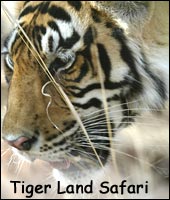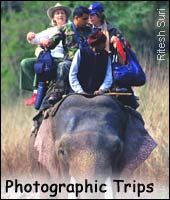HOME : Species of India - Antelopes &
Gazelles
ANTELOPES & GAZELLES
Antelopes are known for their graceful build. The main feature in antelopes is their horns which are more or less cylindrical and marked with rings. The females generally do not have horns in antelopes. Antelopes have a gland beneath the eyes and from outwards it look like a slit on the skin but underneath has a pocket in which a secretion in exuded. They also have large glands between their hooves the sole purpose of these glands is to leave a scent mark for the rest of the members of herd to follow and to know of the presence of a member in an area.Gazelles can be recognized by their color which is normally sandy colored with a white streak on the sides of the face. They also have tufts of hair growing from the knees. In Gazelles both male and female have horns which are fully ringed.
Antelopes and Gazelles prefer open plains and grasslands as their habitat. They have been hunted for their meat by the people over the years and this has resulted in loss of many big herds which once roamed the plains and grasslands of India. In recent years with lot of emphasis given to the protection of animals both antelopes and gazelles have made come back in certain selected areas.
One species of the Antelope which is facing the onslaught of poaching is the Tibetan Antelope also known as the Chiru. It has been hunted very badly for its soft and woolly hair from which shawls and coats are made. It is now mainly found in the Tibetan plateau and under the pressure from all quarters the Chinese government has come out with many plans to protect this creature from poachers.
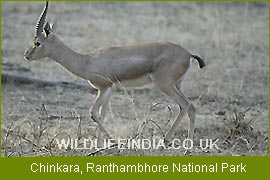 The
Chinkara or Indian Gazelle (Gazella gazelle)
The
Chinkara or Indian Gazelle (Gazella gazelle) A small graceful gazelle with light chestnut color The Chikara is easily recognized by its straight ringed horns and by constant flickering of its tail.
In India the Chinkara is found in the plains and low hills of Punjab, Rajasthan, Uttar Pradesh, Madhya Pradesh and the plains of Deccan.
Chinkara’s are quite shy in nature and tend to run off at the slightest sound. They prefer broken lands interspersed with ravines and nullahs. Chinkara come out to feed mainly in the evenings and are not prone to raid the crops. Chinkara has very well developed sight, smell and sound (hearing).
Chinkara can generally be seen in small groups of 3-4 but sometimes the group size can increase depending on the availability of fodder. They feed on grass, leaves, fruits especially ber and crops in the fields. Chinkara used to the dry and arid land is quite adapt in going without water for long durations. In certain instances they fulfill their need from the dew which forms on the leaves.
Breeding in Chinkara’s is twice in a year and the gestation is mainly for 5 months. The average height of a male Chinkara is around 24-26 inch at shoulder with horns in between 10-12 inches. Male Chinkara are quite territorial and protect their territory from other males.
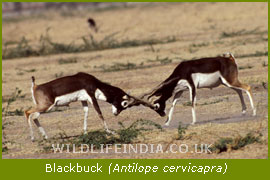 The
Blackbuck or Indian Antelope (Antilope cervicapra)
The
Blackbuck or Indian Antelope (Antilope cervicapra)Blackbuck can be very strongly termed as the most beautiful animal of its kind. It is the only true representative of the genus Antilope in India. It beautiful color and spiral horns gives it great elegance unparallel by any other of its class.
In the younger blackbuck the color is fawn and same is of the doe also but gradually it becomes darker with age. In Southern India the coat of an adult male can be of brownish color. The horns of an adult male Blackbuck can easily reach its own shoulder height and start becoming spiral only from the age of third year.
In the old days Blackbuck was found all over the plains of India in big herds but was decimated by relentless hunting. Mughal king were known to hunt them regularly and used pet cheetahs for hunting the blackbucks.
Blackbuck prefer open plains covered with grass and scrubs. They can also be found near the cultivation fields. They have very keen eyesight and are known for their speed. When alarmed they run in leaps and bounds are known to clear 20-25 ft in a single leap. The herd is always led by the oldest and most seasoned female.
The breeding happens in February and March and during this time the males get into fights, with their horns locked, in order to posses the does.
The Chowsingha or the Four Horned Antelope (Tetracerus quadricornis)
The Chowsingha even though called an antelope is not a true antelope like the Blackbuck. Its horns are not spiral but keeled in front.
Chowsingha or the Fourhorned Antelope is only antelope to have two pairs of horns. The front pair is always shorter then the back pair.
The color of the coat in Chowsingha is dull reddish brown with white on the belly. It has dark colored stripes on each leg with the stripes on forelegs more defined.
Chowsingha is found from Rajasthan to Orissa and in Maharashtra, Karnataka, Kerala, and Andhra Pradesh.
Its ideal habitat is undulating hills with tall grass and sparse forest. It can also be seen near the villages next to the forests. Chowsingha requires water quite frequently and is never far from the water body. Chowsingha lives a solitary life and come together only at the time of mating. As with other antelopes it has a habit of coming back to same place for defecating.
The breeding starts in the hotter months and can continue till the onset of rains. Young ones are born from October onwards till February. The normal gestation period in Chowsingha is 8 months.
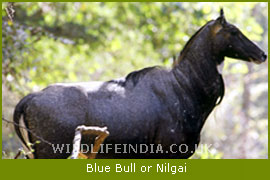 The
Blue Bull or the Nilgai (Boselaphus tragocamelus)
The
Blue Bull or the Nilgai (Boselaphus tragocamelus)An antelope found only in India, the Blue Bull or the Nilgai is unlike antelope in its build. It has a body of horse, face of a cow with high withers and low rump.
An adult bull has a dark grey coat with white ring on each foot. The color of coat in young bulls and cows is tawny. Male bulls have a distinct tuft of black hair on the throat. Bull Nilgai have very stout horns which are triangular at the base and circular towards the tip.
Nilgai is found only in India from the foothills of Himalayas to the forest of Karnataka and from the dry forest of Rajasthan to the forest of West Bengal and Assam.
Nilgai avoid dense forest and prefer the plains with low hills and scrubs. They are prone to raid the cultivation fields and are considered as pests by the farmers. They feed during the mornings and evenings and like to sit in shade in the afternoon. They are both grazer as well as browser and like to feed on leaves and on ber fruits. In central India they are frequently seen eating the fallen flowers of mahua tree. In the grasslands of Rajasthan and Gujarat they can be seen feeding along side black bucks. Nilgai drinks very little amount of water and go for a long period without water in winters and in summers also. The smell and the sight are good in Nilgai and any hint of danger can make them gallop at a very high speed. They have tendency of coming back to same spot for depositing their droppings. It also acts as a mean to meet with all the members of the herd.
The bulls are always seen solitary and the young bulls give company to females and other young ones. The number in a herd is normally around 4-8.
The normal gestation period in Blue Bull is 8-9 months and the mating takes place through out the year.


